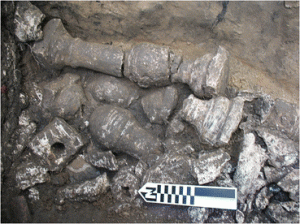Three hundred miles northeast of the ancient city of Cahokia, another urban archaeological site at Chicago’s south side Jackson Park marks a historical turning point eight centuries later. But whereas great effort and resources went into maintaining Cahokia’s mounds for generations, the “White City” fairgrounds of the 1893 World’s Fair were designed to be spectacular but ultimately temporary and subject to demolishment, reflecting the increasing consumerism of a developing industrial Gilded Age America. Catering to over twelve million tourists who visited the fair, the board of architects under Daniel Burnham sought to design and build a magnificent city in the neoclassical Beaux-Arts design as cheaply as possible, balancing expected opulence and expensive infrastructure (including 56 miles of sewers and an electrical system powering over 90,000 lights) with financial constraints (Graff 2011:222; Graff 2012).
In order to achieve this, they used “staff”, a plaster mixture containing jute fibers and horsehair whose particular recipe is often attributed to the 1889 Paris Exposition Universelle. Also appropriately known as “counterfeit marble”, it was the ideal material for the imitative gilding of finishes and facades on the main buildings of the White City. Over 50 large fragments of these plaster columns, urns, and volutes were uncovered in a 1.5 meter deep trench (likely a utility or builder’s trench) in a 2008 archaeological excavation at Jackson Park led by Dr. Rebecca Graff, an associate professor of anthropology at Lake Forest College. These fragments (Fig. 1) were positively identified as part of the fair’s Ohio Building based on comparisons with historical photos (Graff 2012).

Figure 1. Staff fragments discovered in Graff’s 2008 excavation of the former grounds of the Ohio Building. Photograph by R. Graff.
The Ohio Building (Fig. 2) was built to the scale of a grand home or small hotel in a neocolonial style, based on historical documentation. Like many of the state buildings, the Ohio Building was intended to showcase local materials in the design, including terracotta roof tiles found in association with the staff fragments. However, it also functioned as a temporary “pseudo-domestic space” in which tourists could reorient themselves in a space evocative of home when the novelty and excitement of the fair proved overwhelming, as evidenced by associated artifacts like porcelain fragments, pipe stems, and glass cruet tops from bottles of oil and vinegar (Graff 2011:228-229).

Figure 2. The facade of the Ohio Building at the “White City” of the 1893 World’s Fair in Chicago. Photographer unknown.
The archaeological significance of the 1893 fairgrounds has been roped into recent local controversy over the planned construction of the Obama Presidential Center in Jackson Park, which is listed in the National Register of Historic Places (TCLF 2018). A 2017 Illinois State Archaeological Survey on the proposed site found 9,841 artifacts, but state officials say these don’t provide sufficiently significant new knowledge to challenge construction on the basis of the National Historic Preservation Act (Kamin 2018). But regardless, the archaeological evidence of this urban tourism provides insight into a changing American society at the turn of the century as it shifted to a mindset characterized by cheap mass-production and consumerism.
Additional information on the 1893 World’s Fair or concerns over the Obama Center.
References –
The Cultural Landscape Foundation 2018 More Concerns About the Obama Center as Archaeological Report on Jackson Park Faces New Scrutiny. Electronic document, https://tclf.org/more-concerns-about-obama-center-archaeology-report-jackson-park-faces-new-scrutiny, accessed November 17, 2019.
Graff, Rebecca S. 2011 Being Toured While Digging Tourism: Excavating the Familiar at Chicago’s 1893 World’s Columbian Exposition. International Journal of Historical Archaeology. 15(2):222-235.
Graff, Rebecca S. 2012 Dream City, Plaster City: Worlds’ Fairs and the Gilding of American Material Culture. International Journal of Historical Archaeology. 16(4):696-716.
Kamin, Blair 2018 Artifacts from 1893 World’s Fair found beneath Obama center site, but report signals construction won’t be blocked. Chicago Tribune 25 March. Chicago.
The Newberry 2018 The Vanishing City: Excavating the World’s Fair (A Lecture by Rebecca Graff). Electronic document, https://www.newberry.org/10042018-vanishing-city-excavating-worlds-fair, accessed November 17.


